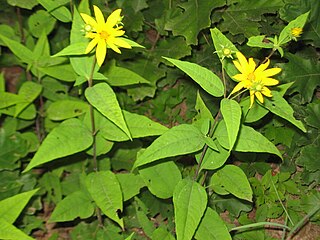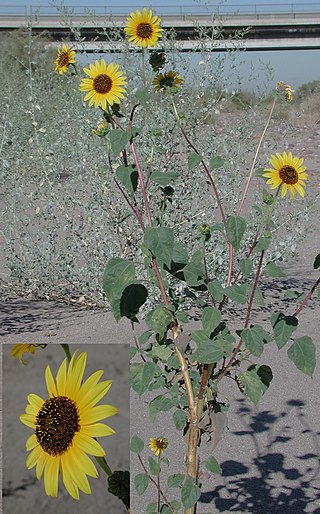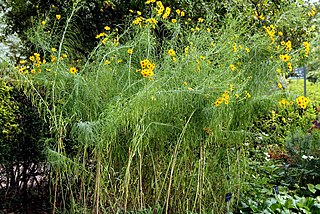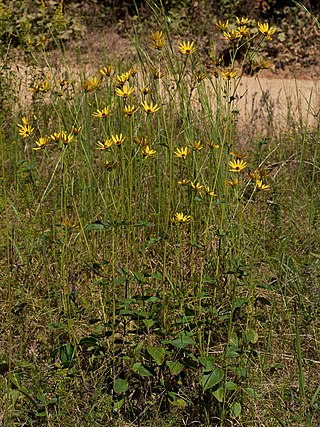
The common sunflower is a species of large annual forb of the daisy family Asteraceae. The common sunflower is harvested for its edible oily seeds which are used in the production of cooking oil.

Helianthus is a genus comprising about 70 species of annual and perennial flowering plants in the daisy family Asteraceae commonly known as sunflowers. Except for three South American species, the species of Helianthus are native to North America and Central America. The best-known species is the common sunflower. This and other species, notably Jerusalem artichoke, are cultivated in temperate regions and some tropical regions, as food crops for humans, cattle, and poultry, and as ornamental plants. The species H. annuus typically grows during the summer and into early fall, with the peak growth season being mid-summer.

Helianthus paradoxus, the paradox sunflower, puzzle sunflower or Pecos sunflower, is a threatened species of sunflower found only in west Texas, Utah, and New Mexico salt marshes by the edges of inland salt lakes and salt flats.

Helianthus nuttallii, or Nuttall's sunflower, is a species of sunflower native to northern, central, and western North America, from Newfoundland west to British Columbia, south to Missouri, New Mexico, and California.

Geraea canescens, commonly known as desert sunflower, hairy desert sunflower, or desert gold, is an annual plant in the family Asteraceae. The genus name comes from the Greek geraios, referring to the white hairs on the fruits.

Helianthus bolanderi is a species of sunflower known by the common names Bolander's sunflower and serpentine sunflower. It is native to California and Oregon, where it grows mainly in mountainous areas, often in serpentine soils. It has been found from southwestern Oregon as well as in northern and central California as far south as Santa Cruz County, with reports of a few isolated populations in southern California.

Helianthus maximiliani is a North American species of sunflower known by the common name Maximilian sunflower.

Helianthus divaricatus, commonly known as the rough sunflower, woodland sunflower, or rough woodland sunflower, is a North American species perennial herb in the family Asteraceae. It is native to central and eastern North America, from Ontario and Quebec in the north, south to Florida and Louisiana and west to Oklahoma and Iowa.

Helianthus grosseserratus, commonly known as sawtooth sunflower or thick-tooth sunflower, is a perennial sunflower in the family Asteraceae, with a large flowering head (inflorescence).

Helianthus decapetalus, known by the common names thinleaf sunflower and thin-leaved sunflower, is a perennial forb in the family Asteraceae. It is native to the Eastern and Central United States and Canada, from New Brunswick west to Iowa, Wisconsin, and Ontario, south as far as Georgia and Louisiana. It produces yellow composite flowers in late summer or early fall.
Helianthus deserticola, the desert sunflower, is a plant species native to Arizona, Nevada and Utah. It grows in dry, sun-lit locations at elevations of 400–1,500 m (1,300–4,900 ft).

Helianthus anomalus, the western sunflower, is a species of plants in the family Asteraceae, found in the southwestern United States.

Erigeron pumilus, the shaggy fleabane, or vernal daisy, is a hairy North American species of perennial plants in the family Asteraceae. It is widespread across much of western Canada and the western United States, from British Columbia east to Saskatchewan and south as far as Oklahoma and the San Bernardino Mountains of California. There have been reports of the plant growing in Yukon Territory, but these were based on misidentified specimens.
Helianthus neglectus is a species of sunflower known by the common names neglected sunflower. It is native to the southwestern United States in southeastern New Mexico and West Texas.

Helianthus mollis is a species of sunflower known by the common names ashy sunflower, hairy sunflower or downy sunflower. It is widespread across much of the United States and Canada, primarily the Great Lakes region from Ontario south to Texas and Alabama. Additional populations are found in the states of the Atlantic Coast from Maine to Georgia, but these appear to be introduced.
Helianthus praecox is a North American species of sunflower known by the common name Texas sunflower. It is endemic to Texas. Most of the populations are either along the Gulf Coast or in the Río Grande Valley.

Helianthus salicifolius is a North American species of sunflower known by the common name willowleaf sunflower. It is native to the central United States, primarily in the Great Plains and Ozark Plateau. There are a few reports of scattered populations in the Northeast and Midwest parts of the country, but these appear to be escapes from cultivation.

Helianthus silphioides is a North American species of sunflower known by the common names rosinweed sunflower or Ozark sunflower. It is native to the central United States, primarily in the Ozarks and the Tennessee Valley with additional populations north into Kentucky and Illinois and south as far as Louisiana, Mississippi and Alabama.
Helianthus smithii is a rare North American species of sunflower known by the common name Smith's sunflower. It is native to the southeastern United States, in Tennessee, Alabama, and Georgia.

Charles Bixler Heiser Jr. (1920–2010) was a professor of botany, known as a leading expert on the sunflower genus Helianthus. He is also noteworthy as the author of a "series of popular books that did much to promote botany to the general public."



















